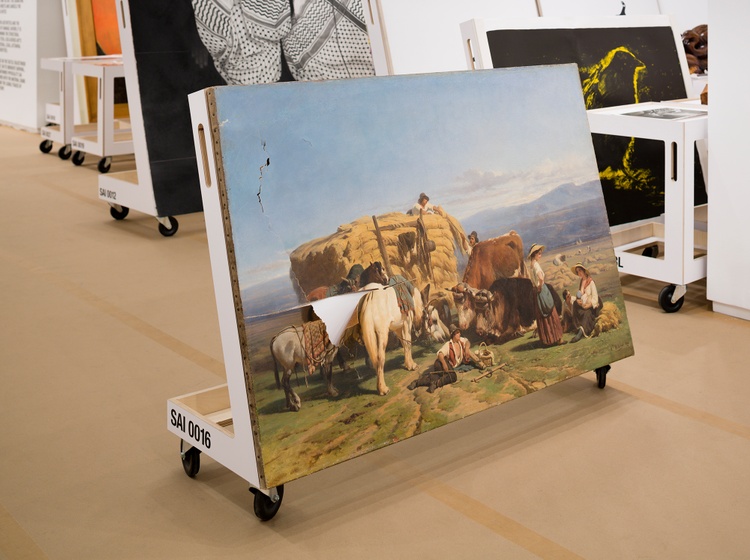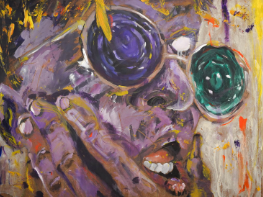Art restorers work to salvage damaged works of art
IMAGE COURTESY OF JAMES EWING, SALVAGE ART INSTITUTE
Alexandre Dubuisson’s La Moisson was damaged in transport in 2010 and on display at the Salvage Art Institute.
January 17, 2020
Art restoration is the process of repairing damage to artwork such as paintings, textiles, sculptures and other artifacts. Art restorers take it upon themselves to maintain the piece’s authenticity, even centuries after its original embellishment. To do so, they use a variety of different techniques and technologies, ranging from the use of human saliva as an enzyme for removing grime to the use of a macroscopic X-ray to analyze individual pigments. Although these processes are designed to thoroughly replicate the artists’ authentic procedure, the idea of another individual painting over the blemishes of a 16th century painting with 21st century acrylics is often frowned upon.
Art restorers believe that they are giving old pieces of art that are victims of aged grime and dirt a new life. Rhona Macbeth is a professional art conservator at the Museum of Fine Arts in Boston, where professionals are constantly tweaking pieces of art to keep the original picture in existence.
“As best as we possibly can, we want to be true to that idea of artist intent. . .What we’re trying to do is take away the barriers between the artist’s original vision and the viewer,” Macbeth said in an interview with CBS.
Despite these articulant processes, the stance of the original artist remains in question. Chris Stavroudis, an art restorer hired by the Museum of Contemporary Art in Los Angeles, has recently worked on restoring the art of Jackson Pollock.
“And actually, when you’re working on any artist’s work, you wonder what they would think,” Stavroudis said in the same interview. “But I think the idea of somebody taking the time to conserve his work, making it last for posterity, I think he’d be thrilled.”
Although some might argue that artists would want to see their art outlive the dangers of time, others may feel disrespected by others putting their paint, pencil and tools into a piece that was once part of the artist. Joseph Gerbs, student at the Savannah College of Art and Design , fabricates abstract paintings in his leisure time – each piece representing a different chapter of his life.
“I would want to keep its original touch, it’s different if someone wanted to redraw something I did with revitalized colors but I feel like the original piece needs to keep its history and remain untouched,” Gerbs said.
Often times, a reproduced image, although in pristine condition, is not as precise as the artist’s intended portrayal.
Through a different lens, damaged art in itself can be its own form of beauty. Why not consider displaying these pieces with the age, history, authenticity and erosion they hold instead of immediately resorting to restoration? This was the journey of the Salvage Art Institute (SAI), founded in New York City in 2009.
The traveling exhibit was founded by Polish artist Elka Krajewka, who created the SAI as ‘a haven for all art officially declared as total loss, removed from art market circulation.’ The exhibit includes art that has been deemed worthless, abandoned, or too destroyed to even be restored. She was “delighted that the work – although damaged – had a second life.”
Krajewka displays these pieces along with a short narrative describing the pieces’ life: the artist, where the painting was originally hung and why it has been abandoned. Unlike other art museums, visitors are allowed to touch the art and physically feel the strokes of the brush and imprents of the pencil.
Along with this interactive experience, Elka Krajewska hopes that the SAI will not only give these pieces another life, but also redefine the meaning of preserving treasured art. The art market’s foremost goal is to restore the financial value of the piece, rather than the art it holds. Keeping the price of the painting has become an objective rather than keeping the message of the artist.
The act of using modern techniques to bring back century old pieces of art into their original authentic light is often a contradiction. Although professionals say that they are keeping the artists’ vision alive, some artists themselves may disagree, wanting to display the art regardless of damage. In this way, the work of the artist remains imbedded into their piece, allowing it to live with every detail from its initial pencil sketch to its final brush stroke.














